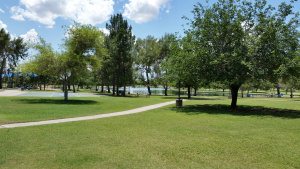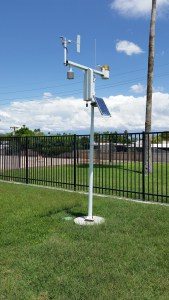
Indian Bend Wash is a community playground, but its first purpose is flood control. The wash moves and controls stormwater to protect homes and businesses during heavy rains. The project was once envisioned as a concrete channel, but Scottsdale and the U.S. Corps of Engineers came together to build a green option.
The wash includes seven levies, is built using rainwater-harvesting techniques, and carries the outflow from surrounding stormwater drains into the Salt River bottom. Grass and trees stabilize the ground in the wash, so it is not carried away during heavy storms and runoff.
Indian Bend Wash is home to a sophisticated weather station that indicates how much water the soil, grass, trees, and plants have lost during the day. The technology helps park supervisors know exactly how much water to apply to keep their parks thriving. That’s important because all park supervisors are given water budgets for the year that they are expected to meet or beat.
Here’s how that budget is determined: The Arizona Department of Water Resources regulates the maximum amount of water a city, a business or an HOA can use per acre of turf. The regulation applies to any area that has 10 or more acres of grass. Only eight of Scottsdale’s parks have 10 or more acres of turf, but that doesn’t matter to Scottsdale leaders. They beat the regulation for all of the city’s parks.

In 2001, the Scottsdale Parks and Recreation Department made it a goal to use 15 percent less water than allowed by the state’s regulation on turf in all 42 of the city’s parks. The city has an irrigation manager dedicated to accomplishing that goal. Here are six additional ways the city controls the amount of water used on its grass. These measures can help you with your lawn, too.
1. Watch for leaks. A central irrigation control system automatically shuts down when it senses a break in a park’s line or control valve. Before the installation of the technology, a line could waste water for hours before being spotted by a park worker or reported by a citizen.
2. Turn off the irrigation system during rainstorms. During storms, irrigation systems in every park can be shut down from a laptop computer. Sometimes the city intentionally runs the irrigation systems in the Indian Bend Wash during a rainstorm. That’s because the irrigation water in the wash comes from its lakes. Operating the irrigation system during a storm prevents the lakes from overflowing and flooding pedestrian paths.
3. Check for spikes in water use. Each month, the city’s irrigation manager receives a water use report from each park. If the park has exceeded its water budget, the irrigation manager follows up with the park supervisor to find out why. The park supervisor is expected to make up for the excess water used during the following months. Park supervisors are evaluated based, in part, on their year-end water-use totals.
4. Don’t overseed in the winter. The city does not plant winter grass in most parks. The Bermuda grass goes brown during the cooler months. It is still alive but dormant. The exceptions are Scottsdale Stadium and Indian School Park used by spring training teams, parts of Civic Center Mall used for community events, and the plaza area of McCormick Railroad Park.
4. Shrink the lawn. The city has converted some grass to drought-tolerant landscape in areas that make sense for the community surrounding the park. To date, Scottsdale has replaced 323,618-square-feet of grass with drought-tolerant gardens.
5. Understand the irrigation system. All park staff members are trained in water management and irrigation maintenance.
Scottsdale measures its success by comparing the water it uses to irrigate its parks to the amount allowed by the Arizona Department of Water Resources. Between 2001 and 2014, the city used 2 billion gallons less than the state allows, savings to the city of $3.7 million.
Cities offer free workshops for homeowners who need to brush up on irrigation basics. Not the way you want to spend your evening? Hire a landscaper who has completed professional training and certification. A good place to start is with Smartscape professionals.
For 46 years, Arizona Municipal Water Users Association has worked to protect our member cities’ ability to provide assured, safe and sustainable water supplies to their communities. For more water information visit www.amwua.org.

